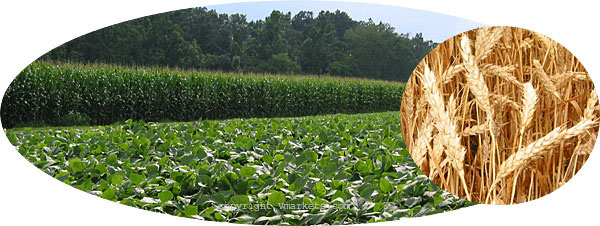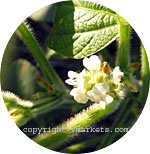
 |
|||
|
| |||||||||||||||||||||
|
Corn Cropping Systems A cropping system is a group of components, methods, or procedures that are used in the act of growing plants for the production of food for fiber. Most systems are unique to an individual farm and sometimes to an individual field. The key to successful cropping systems lies in the selection of the components. The components of a corn cropping system are crop sequence, crop management, soil management, pest management, and marketing. First, the farmer must identify the goals for his farming enterprise. The description and ranking of priorities is important because they determine what crops are grown and which crop sequence to use.  There are many cropping sequences which are used in growing corn in North Carolina. Crop rotations have become the most common type of corn cropping sequence. They have the advantages of reducing pest, disease, and weed problems. Rotations can improve the use and availability of nutrients, and with the proper selection of a rotation crop, the productivity of the system can be improved. Corn-soybean, cotton-corn, or corn-wheat-soybean cropping sequences work well in North Carolina; particularly, on highly productive soils.
There are many cropping sequences which are used in growing corn in North Carolina. Crop rotations have become the most common type of corn cropping sequence. They have the advantages of reducing pest, disease, and weed problems. Rotations can improve the use and availability of nutrients, and with the proper selection of a rotation crop, the productivity of the system can be improved. Corn-soybean, cotton-corn, or corn-wheat-soybean cropping sequences work well in North Carolina; particularly, on highly productive soils.Next, the farm manager must select components that will maximize efficiency and productivity. The keys to high net returns are to obtain maximum productivity and to do so in the most efficient manner. Using the same planter to plant two different crops is an example of efficient use of resources. Third, to maximize profit of the cropping system, the farm manager must identify his customers and take steps to meet their needs. Market management is one of the most important components of a corn cropping system. Selecting and managing crop production to target a specific market or customer leads to success in a farming enterprise. The trick to marketing is to identify your customer and take steps to meet his needs. Today, most of the corn growers in North Carolina market their corn in an Open Market system. In this system, they sell their own corn to the highest bidder in the marketplace. This system has the advantage of giving the grower maximum flexibility in selecting management practices; however, the risk in this system is that customers will be disappointed by the quality of the grain or will seek grain from producers who can sell at lower prices. Contract markets are perhaps the best example of targeting the customer and tailoring a cropping system to meet his needs. Integrated markets in which a producer will feed his grain to his own livestock are becoming more scarce as livestock operations become larger and more specialized. Finally, the farm manager must constantly evaluate all components in a cropping system and their role in meeting the needs of the customer and the goals of the farm enterprise. A producer who is not ready to change will soon find his system is unprofitable and unproductive. Keeping abreast of changes in crop management and using the information available to him from outside sources such as the Cooperative Extension Service or his input supplier is an important part in this evaluation process. A cropping systems approach to farm management provides the producer with the tools needed to meet his individual goals. Instead of following the leadership of others, a producer with a cropping systems approach can tailor his farm enterprise to meet his needs and the needs of those who depend on him/her for their sustenance. Crop Management Hybrid selection is a critical component of any profitable corn production system. Skillful hybrid selection requires that growers: Corn hybrids fall into three categories, single crosses, three-way crosses and double-crosses. Single crosses, derived from the crossing of unrelated inbred lines, are characterized by uniformity of plant height, ear height and yield. This uniformity improves machine harvesting and is most advantageous when growing conditions are favorable. The three-way cross is slightly less uniform than the single cross because it is created by hybridizing a single cross seed parent with an unrelated pollen parent inbred. The double-cross is developed from four unrelated inbreds. It is less uniform in plant height, ear height, silking date, etc. than the single or three-way cross. Genetic engineering is a powerful, new hybrid development tool that is complementing traditional plant breeding. Genetic engineering is currently being used to introduce traits that confer insect, herbicide, or disease resistance to existing hybrids. Instead, selection of a genetically-engineered hybrid should depend on whether the resistant traits that hybrid has are needed in the corn cropping system. For most growers selecting corn hybrids, yield is the primary consideration. However, successful corn producers choose hybrids on the basis of agronomic characteristics that complement their specific farm environment. For example, medium maturity, standability, seedling vigor and leaf disease tolerance are critical on farms comprised of organic soils. Livestock producers value good grain quality, while many piedmont and mountain bottomland silage growers demand gray leaf spot and viral disease tolerance. Corn producers should plant several hybrids differing in maturity. A 300-acre corn producer, for example, should plant a minimum of three hybrids. Planting hybrids that differ in maturity increases the odds that corn will be combined at optimum grain moisture levels throughout the harvest season and minimizes risk caused by the adverse effects of short-term water deficits and high temperatures. In North Carolina, the highest corn yields are produced by medium-season hybrids with a relative maturity of 110 to 118 days. To simplify hybrid selection, the process may be divided into eight steps that generate intelligent hybrid selections and increased corn profits. Step 1) Analyze the role of corn on the farm & identify traits needed in an operation. Step 2) Ask for product information describing the agronomic traits. Step 3) Obtain hybrid data from independent sources: Extension agent and ask for N.C. State University's statewide corn variety testing results. Step 4) Discuss corn hybrid performance with seed dealers, grain buyers and farmers. Step 5) Make a list of hybrids that appear repeatedly at the top of yield comparisons and yield contest summaries. Step 6) Eliminate those hybrids that do not meet your special requirements. Step 7) Choose from the hybrids remaining on your "short list". Step 8) Conduct your own hybrid comparisons. | |||||||||||||||||||||
 | |||||||||||||||||||||
| Small Grains You can grow small grains for a cash crop, livestock feed, or as a cover crop for soil and water conservation. You should plant the best varieties available as this is important in the successful production of small grains. Choose the kinds of small grains and varieties that are best for your needs. Varieties will perform differently at various locations and under different environmental conditions. There are significant differences in characteristics among varieties of each kind of grain. There are several different factors that must be considered, such as: resistance to lodging, diseases, and insects; maturity; winter hardiness and ability to withstand adverse weather conditions; milling quality; and test weight should be considered. Getting the small grain crop off to a good start is the first step towards a successful farming season. The success of planting or establishing a small grain crop depends on seed source, seedbed preparation, method of planting, seeding dates and rates. Soil testing helps provide precision management. Nutrients must be kept at optimum levels both for small grains and for crops that follow. Soils tests from specific fields are the best way to determine how much lime and fertilizer-supplied nutrients should be added. Soil tests will also aid in providing an adequate supply of nutrients for subsequent crops. Soil samples should be collected and tested approximately 2-3 months before planting. Soil testing is a service provided by the Agronomic Division of the North Carolina Department of Agriculture. You can simply bring in a sample to your local County Extension Office, drop it in a soil sample box, fill out the appropriate forms, and they will send it off for you. Small grain crops must be harvested with minimum loss to realize the greatest return from the money and labor invested in producing the crop. Minimum loss is achieved by harvesting on time with a combine that is adjusted and operated properly. |
|||||||||||||||||||||
| North Carolina Department of Agriculture & Consumer Services - County Statistics | |||||||||||||||||||||
| |||||||||||||||||||||
|
| |||||||||||||||||||||
Soybeans Soybean production in North Carolina ranges across the Coastal Plain and into the Piedmont. Soybeans are typically the state's largest acreage row crop, with 1.2 to 1.5 million acres annually. Average farm-gate value of the state's soybean crop is approximately $200 million, ranking it 3rd behind tobacco and cotton. Soybean production in North Carolina ranges across the Coastal Plain and into the Piedmont. Soybeans are typically the state's largest acreage row crop, with 1.2 to 1.5 million acres annually. Average farm-gate value of the state's soybean crop is approximately $200 million, ranking it 3rd behind tobacco and cotton.Within this geographic range the likelihood of economic loss to insects is highly variable. Soybeans harbor many species of insects. The corn earworm is by far the most important insect pest of soybean in North Carolina. The soybean plant has an amazing capacity to tolerate insect attack when grown under favorable conditions. Since soybean is a low value per acre crop, close attention must be given to producing the highest possible yield at the least cost. On the other hand, a common problem that some NC soybean growers demonstrate is a lack of attention in detecting and controlling damaging insect problems when they do occur. Managing crop pests involves a consideration of agronomic, economic, and biological factors. Soybean is a low value crop that can not support high cost pest management techniques. | |||||||||||||||||||||